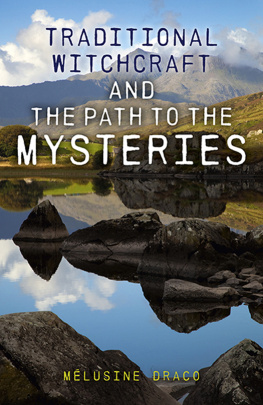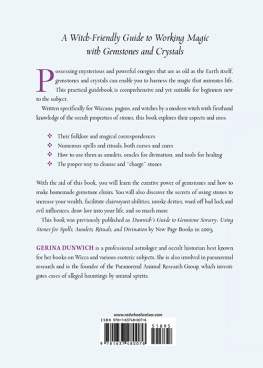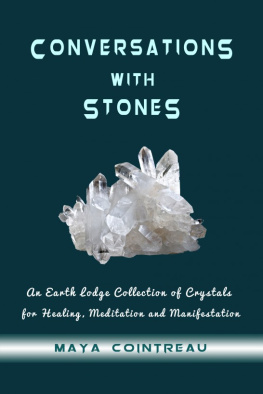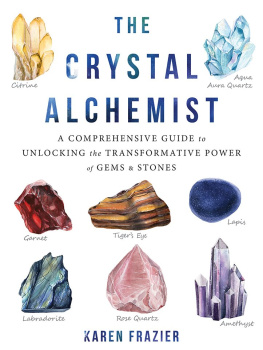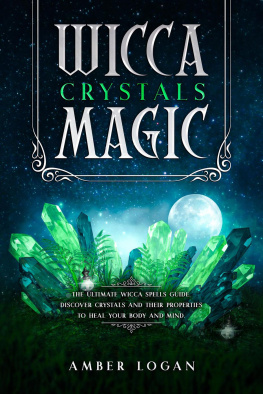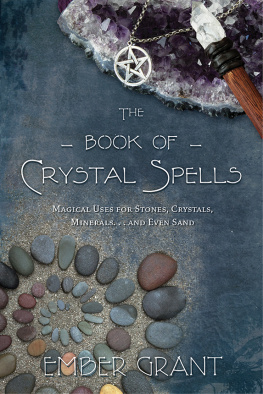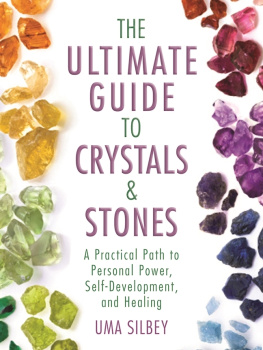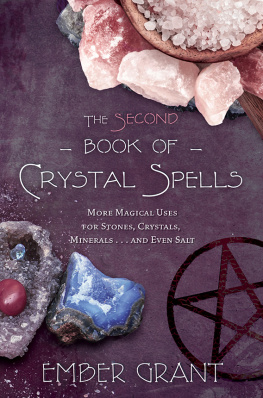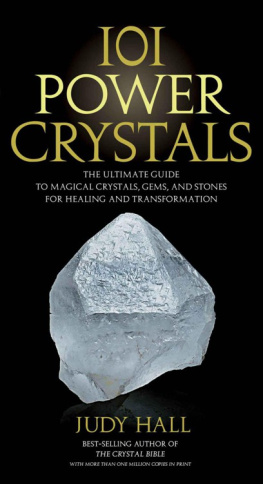Draco - Magic Crystals, Sacred Stones
Here you can read online Draco - Magic Crystals, Sacred Stones full text of the book (entire story) in english for free. Download pdf and epub, get meaning, cover and reviews about this ebook. publisher: John Hunt Publishing, genre: Religion. Description of the work, (preface) as well as reviews are available. Best literature library LitArk.com created for fans of good reading and offers a wide selection of genres:
Romance novel
Science fiction
Adventure
Detective
Science
History
Home and family
Prose
Art
Politics
Computer
Non-fiction
Religion
Business
Children
Humor
Choose a favorite category and find really read worthwhile books. Enjoy immersion in the world of imagination, feel the emotions of the characters or learn something new for yourself, make an fascinating discovery.

Magic Crystals, Sacred Stones: summary, description and annotation
We offer to read an annotation, description, summary or preface (depends on what the author of the book "Magic Crystals, Sacred Stones" wrote himself). If you haven't found the necessary information about the book — write in the comments, we will try to find it.
Magic Crystals, Sacred Stones is aimed at those who have explored crystal working as a beginner and who now wish to understand the mysteries of the Earth at a deeper level.
Magic Crystals, Sacred Stones — read online for free the complete book (whole text) full work
Below is the text of the book, divided by pages. System saving the place of the last page read, allows you to conveniently read the book "Magic Crystals, Sacred Stones" online for free, without having to search again every time where you left off. Put a bookmark, and you can go to the page where you finished reading at any time.
Font size:
Interval:
Bookmark:

Axis Mundi Books provide the most revealing and coherent
explorations and investigations of the world of hidden or
forbidden knowledge. Take a fascinating journey into the realm
of Esoteric Mysteries, Magic, Mysticism, Angels, Cosmology,
Alchemy, Gnosticism, Theosophy, Kabbalah, Secret Societies and
Religions, Symbolism, Quantum Theory, Apocalyptic
Mythology, Holy Grail and Alternative Views of Mainstream
Religion
Alchemy, Diana Fernando (Blandford)
Ancient Energies of the Earth, David Cowan and Anne Silk (Thorsons)
Britain BC , Francis Pryor (Harper Collins)
Calendars & Constellations , Emmeline Plunket (Senate)
Chinese Gods: The Unseen World of Spirits & Demons , Keith Stevens (Collins & Brown)
Concise Encyclopaedia of Heraldry, Guy Cadogan Rothery (Bracken)
The Curious Lore of Precious Stones, George Frederick Kunz (Dover)
Earth Mysteries, Philip Heselton (Element)
The Equinox , Aleister Crowley (Falcon)
A Field Guide to Rocks & Minerals, Frederick H. Pough (Constable)
Gems From The Equinox , Aleister Crowley (Weiser)
The Gemstones Handbook , Christine Sempers (Raven)
Geology, I. O. Evans (Warne)
Geology & Scenery in England & Wales , A. E. Trueman (Pelican)
The Goat-Foot God, Dion Fortune (Aquarian)
History of Art , H. W. Janson (Reprint Society)
The Hollow Tree , Mlusine Draco (ignotus)
How To Make Amulets, Charms & Talismans , Deborah Lippman and Paul Colin (Cassell)
Illustrated Encyclopaedia of Minerals, ed. Dr Alan Woolley (Gallery)
Journeys From the Centre of the Earth , Iain Stewart (Century)
Liber 777 , Aleister Crowley (Weiser)
The Making of the English Landscape , W. G. Hoskins (Pelican)
The Magical Arts , Richard Cavendish (Arkana)
Magical Jewels, Joan Evans (Dover)
Mineral & Rocks, Keith Lye (Rainbow)
Needles of Stone, Tom Graves (Gothic Image)
Pebble Polishing, Edward Fletcher (Blandford)
The Penguin Dictionary of Geology, D. G. A. Whitten with .J R. V. Brooks (Penguin)
The Phenomenology of Landscape, Christopher Tilley (Berg)
Pocket Guide to Minerals , Andrew Clark (Gallery)
Priestess, Alan Richardson (Aquarian)
Qabalistic Writings of Aleister Crowley (Weiser)
Riches of the Earth , Frank J. Anderson (Windward)
Ritual Magic , Elizabeth M. Butler (Sutton)
Rocks & Minerals, E. P. Bottley (Octopus)
The Secret Country, Janet and Colin Bord (BCA)
A Study of History , Arnold Toynbee (BCA)
Talisman, Charms & Amulets, Robert W. Wood (Rosewood)
Traditional Witchcraft for the Seashore , Melusine Draco (O-Books)
Traditional Witchcraft for Urban Living , Melusine Draco (O-Books)
Treasures of the Earth, ed by Chris Pellant (Orbis)
Spells, Charms, Talismans & Amulets, Pamela A. Ball (Arcturus)
What You Call Time , Suzanne Ruthven (ignotus)
In classical Greek mythology, Zeus being angered by the deeds of men, decided to destroy the whole of mankind by flood. Deucalion, a son of Prometheus, was warned by his father of the forthcoming Deluge and, with his wife Pyrrha, built a boat to ride out the storm. When the waters subsided, they found themselves on Mount Parnassus, where the oracle advised them to throw over their shoulders the bones of their mother. Understanding this to refer to the stones of the Earth, they did as they were directed, and from the stones thrown by Deucalion there sprang up men, and from those thrown by Pyrrha, women. This is, of course, only one of the many global myths about the Deluge but from a magical perspective it is the earliest and most evocative one that identifies the sacred stones of the earth as the bones of the Earth Mother.
Closer to home, we know our ancestors began to utilise these bones during the late Stone Age, when early man began to make stone hand-axes and later, to fashion razor-sharp blades from flint; the most sought-after raw material in antiquity being a volcanic glass called obsidian. And from there it was only a small step to creating items for personal adornment because man was now capable of perforating certain stones, which he wore openly on his person instead of carrying them about in a pouch, much as a shaman or medicine-man might.
Rocks are made up of specific combinations of minerals, and the endless ways in which these minerals combine results in the huge variety of rocks and landscapes we see in Nature. At this period of history, the geological impact on the lives of the people is also demonstrated by the relationship between prehistoric sites and their topographical settings. According to Christopher Tilley in A Phenomenology of Landscape , the architecture of Neolithic stone tombs focussed the attention on landscape features, such as rock outcrops, river valleys and mountain spurs in the immediate vicinity. And as each culture developed in different parts of the world, whatever rocks were found beneath their feet would become the building blocks for their sacred monuments.
The primitive associations with funerary customs and emerging ancestor worship were openly expressed by the recognition of some supernatural force that could influence or change the course of events. Of the sacredness of stones among peoples in the early stages of civilisation, Sir James Frazer ( The Golden Bough ) wrote extensively on the many examples from different cultures, especially of the efficacy of such stones in the making of oaths. As civilisation slowly developed, colourful or translucent stones, would probably have acquired commonly recognised qualities and associations, observed Frank J. Anderson in Riches of the Earth: Some worn as plaques or amulets, conferred the protection and guidance of supernatural beings, while others became the insignia of power and prestige. Jewellery had also evolved into both royal and ecclesiastical regalia.
Foreign traders were introducing all different kinds of stones into Britain in the form of tools, jewellery and other artefacts, which demonstrates that the cutting, carving and importing of stones was already an established industry. For example, a jadite axe head found at the Neolithic Sweet Track site, was identified by experts at the British Museum as having its source at the foothills of the Alps. Baltic amber has been discovered at Goughs Cave, and archaeologist Francis Pryor asks whether some routes whereby this (and other) materials found their way to Britain were beginning to emerge as early as late glacial times.
Even from that very early time in mans history, the Earths precious minerals were recognised as having a value that could be exploited and/or revered once they had been extracted from the rocks beneath their feet. The most visible examples of these minerals are stones and rocks and, with the notable exception of mercury, are heavy, hard and compact solid masses that form the shapes we recognise as crystals. And a crystal is a substance that has a constant, regular shape, even when ground down into tiny particles, each individual particle still retains the shape of the original crystal it came from, which is all part of its magic.
Minerals are natural substances that form inside a variety of different rock types, and at present, there are nearly 3000 different named varieties. This number is always increasing in fact, some 30 or more new minerals are discovered every year, while others are struck off the list once scientific analysis reveals they do not fulfil all the necessary criteria. When all the registered names of minerals are taken into account, they total nearly 15,000, including all the different types, variations and obsolete names. Of these, only about 30 are common at the Earths surface, and make up the bulk of the rocks we can discover on our magical quest.
Font size:
Interval:
Bookmark:
Similar books «Magic Crystals, Sacred Stones»
Look at similar books to Magic Crystals, Sacred Stones. We have selected literature similar in name and meaning in the hope of providing readers with more options to find new, interesting, not yet read works.
Discussion, reviews of the book Magic Crystals, Sacred Stones and just readers' own opinions. Leave your comments, write what you think about the work, its meaning or the main characters. Specify what exactly you liked and what you didn't like, and why you think so.

